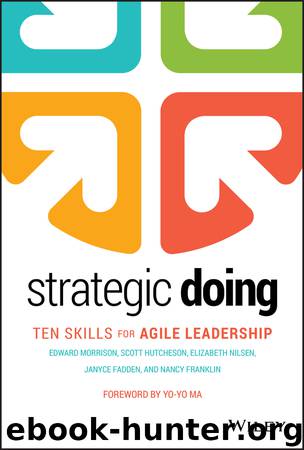Strategic Doing by Edward Morrison & Scott Hutcheson & Elizabeth Nilsen & Janyce Fadden & Nancy Franklin

Author:Edward Morrison & Scott Hutcheson & Elizabeth Nilsen & Janyce Fadden & Nancy Franklin
Language: eng
Format: epub
ISBN: 9781119578406
Publisher: Wiley
Published: 2019-05-07T00:00:00+00:00
DEALING WITH DOUBTS AND DOUBTERS
This way of choosing a direction may seem quite unscientific. In fact, it depends on the powerful idea of group intuition. When there is a complicated choice to be made, one individual may or may not know exactly how much impact an idea will have, or how easy it will be to pull it off. However, if a group of reasonably well‐informed people all make individual judgments about the two dimensions of impact and ease, the combined weight of all of those judgments will lead the group in the right direction. In our experience, by using a 2×2 matrix to surface a shared strategic intuition, teams gain insights faster, learn faster, and act faster.
The odds are that the opportunity chosen really is your Big Easy. But what if you encounter doubters? Structuring your next steps in the same way that software developers do – taking baby steps to “try out” the Big Easy – is one way to respond to that worry. If the first steps toward your Big Easy opportunity prove that it was a dud, the group can easily go back and focus on another opportunity. This “tryout period” is an important advantage of agile strategy over traditional strategic planning. When months and thousands of dollars have been spent developing a strategic plan, it's very difficult to admit that some of the assumptions were wrong. With agile strategy, a limited amount of time will be “wasted” should the team be heading down what turns out to be a wrong path. Even if the group chooses the wrong opportunity to start, they will likely learn a lot from failure. If they quickly assess what's wrong and move on to another opportunity, chances are they have also strengthened habits of shared learning and candid communication. Facing hard facts together also builds trust. In this way, agile strategy enables you to manage risk in a way that traditional strategic planning never can.
Another common hesitation about using the Big Easy method is that it might appear to be premature to make any decision at all. That is, some members of the group may feel they need more information. But there is a real risk of delaying a decision on which opportunity to pursue. The group can become fixated on infinite fine tuning, ranking and reranking. Looking for more data can simply delay moving ideas into action. Because we are confronting complex, adaptive challenges, we must accept four realities. First, delay – too much talk without action – erodes trust. If getting more information is simply an excuse for not doing anything, the trust in your group will begin to evaporate. Second, it is impossible to have enough information to analyze a complex challenge completely before we begin. Third, we will only really learn about this complex challenge when we begin to do something together. We need to experiment and test our ideas. Fourth, you can be continuously both “generating” and “consuming” data by asking questions as you move forward.
Download
This site does not store any files on its server. We only index and link to content provided by other sites. Please contact the content providers to delete copyright contents if any and email us, we'll remove relevant links or contents immediately.
Bad Blood by John Carreyrou(6559)
Rich Dad Poor Dad by Robert T. Kiyosaki(6414)
Principles: Life and Work by Ray Dalio(6236)
Playing to Win_ How Strategy Really Works by A.G. Lafley & Roger L. Martin(5945)
Management Strategies for the Cloud Revolution: How Cloud Computing Is Transforming Business and Why You Can't Afford to Be Left Behind by Charles Babcock(4528)
The Confidence Code by Katty Kay(4193)
Thinking in Bets by Annie Duke(4154)
American Kingpin by Nick Bilton(3762)
Delivering Happiness by Tony Hsieh(3369)
Project Animal Farm: An Accidental Journey into the Secret World of Farming and the Truth About Our Food by Sonia Faruqi(3179)
The Power of Habit by Charles Duhigg(3064)
The Tyranny of Metrics by Jerry Z. Muller(3008)
Brotopia by Emily Chang(3002)
Mastering Bitcoin: Programming the Open Blockchain by Andreas M. Antonopoulos(2986)
The Marketing Plan Handbook: Develop Big-Picture Marketing Plans for Pennies on the Dollar by Robert W. Bly(2979)
I Live in the Future & Here's How It Works by Nick Bilton(2941)
The Content Trap by Bharat Anand(2864)
Building a StoryBrand by Donald Miller(2844)
Applied Empathy by Michael Ventura(2839)
